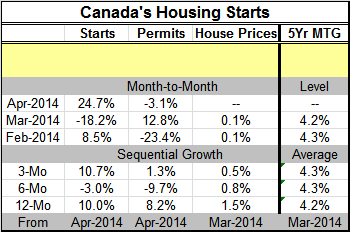 Global| Jun 09 2014
Global| Jun 09 2014Canadian Housing Starts Show Some Spunk and Promise
Summary
Housing starts in Canada rebounded by a huge 24.7% in April after falling by 18.2% in March. Volatility around this time of year is normal for Canada. Sometimes it comes in Jan/Feb; this year it came a month later. Momentum in starts [...]
 Housing starts in Canada rebounded by a huge 24.7% in April after falling by 18.2% in March. Volatility around this time of year is normal for Canada. Sometimes it comes in Jan/Feb; this year it came a month later.
Housing starts in Canada rebounded by a huge 24.7% in April after falling by 18.2% in March. Volatility around this time of year is normal for Canada. Sometimes it comes in Jan/Feb; this year it came a month later.
Momentum in starts has been fading since starts peaked at 21,027 in April 2012.
Five-year Canadian mortgage rates dropped to 4.02% in April from 4.16% in May. Rates have been falling for six months without an interruption. Since May 2012, the 5-year MTG rate has averaged 4.22%. With the ongoing drop rates have been below that average for two months in a row.
The outlook for rates to stay low is good. Headline inflation in April just jumped up to 2.1%. It was last at 2% 24 months ago. In the intervening period, inflation has averaged less than 1.1%. The Bank of Canada has been undershooting its 2% inflation target the same as every other G-7 central bank. However, in setting policy, the Bank of Canada also looks at the CPI stripped of its most volatile components, the CPIx. Currently the CPIx shows breathing room for the central bank as it is up by only 1.5% year over year. It too has been undershooting.
The prospect for mortgage rates to stay low to stimulate housing is therefore pretty good. The underlying Canadian economy is doing fine with a 2.6% rate of growth in Q1. Retail sales growth hovers around the 4% mark. Canada has enough economic activity to support housing. Its unemployment rate has fallen substantially from its cycle peak, but it is still substantially above its cycle low. Canada will want to grow more, faster. In this sense, with its unemployment (employment) needs and inflation condition, Canada has circumstances much like the US.
But in Canada housing market home prices are not rising as fast as in the U.S. But the slowdown in price appreciation appears to have turned to a stable 1.5% pace year-over year- still just above the rate of inflation.
Housing in Canada seems to have stabilized. Economic growth is moderate and housing prices are tracking at just above the level of inflation. Year over year starts are up by a strong 10% in April, but they have moved with volatility over the past five months. Starts seem to be emerging from period in which they steadily declined to show growth.

Robert Brusca
AuthorMore in Author Profile »Robert A. Brusca is Chief Economist of Fact and Opinion Economics, a consulting firm he founded in Manhattan. He has been an economist on Wall Street for over 25 years. He has visited central banking and large institutional clients in over 30 countries in his career as an economist. Mr. Brusca was a Divisional Research Chief at the Federal Reserve Bank of NY (Chief of the International Financial markets Division), a Fed Watcher at Irving Trust and Chief Economist at Nikko Securities International. He is widely quoted and appears in various media. Mr. Brusca holds an MA and Ph.D. in economics from Michigan State University and a BA in Economics from the University of Michigan. His research pursues his strong interests in non aligned policy economics as well as international economics. FAO Economics’ research targets investors to assist them in making better investment decisions in stocks, bonds and in a variety of international assets. The company does not manage money and has no conflicts in giving economic advice.






